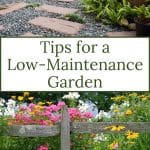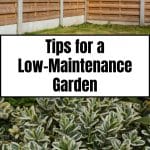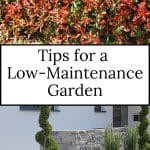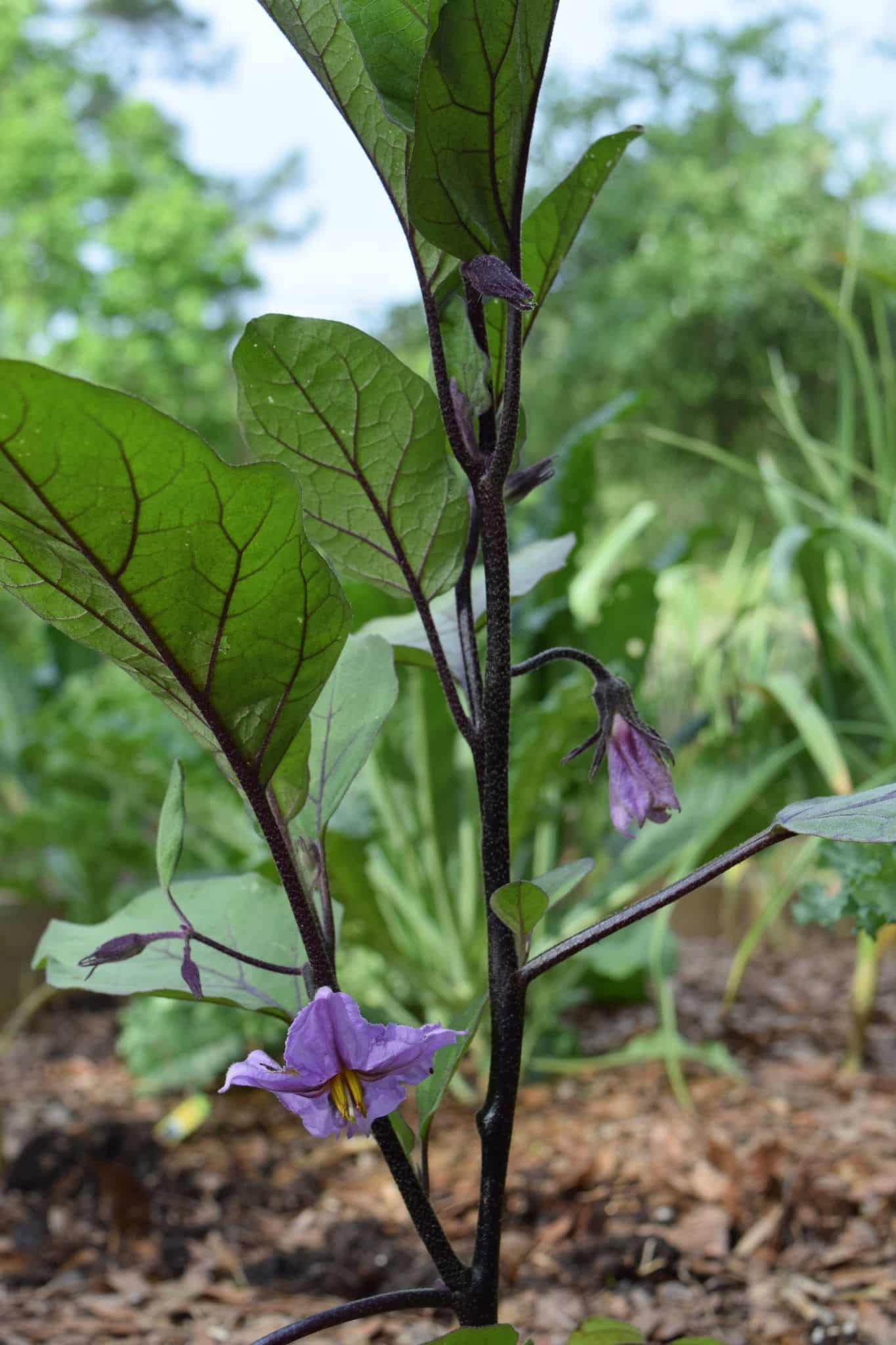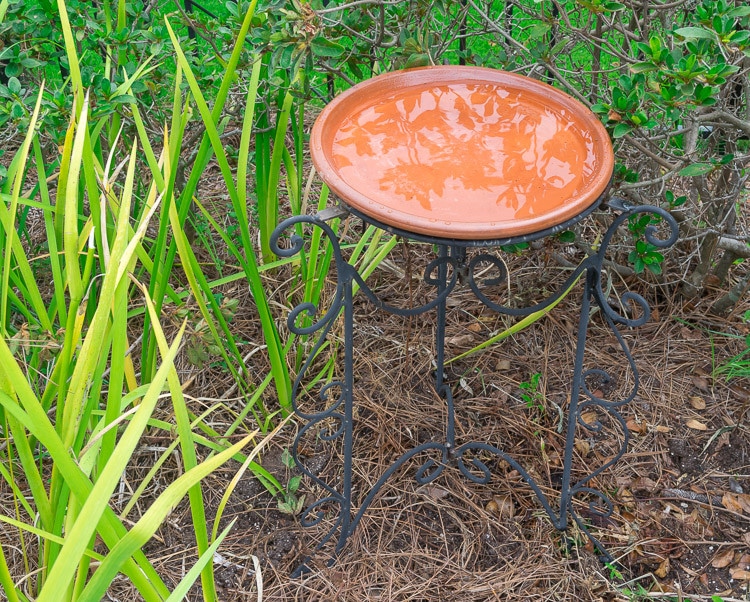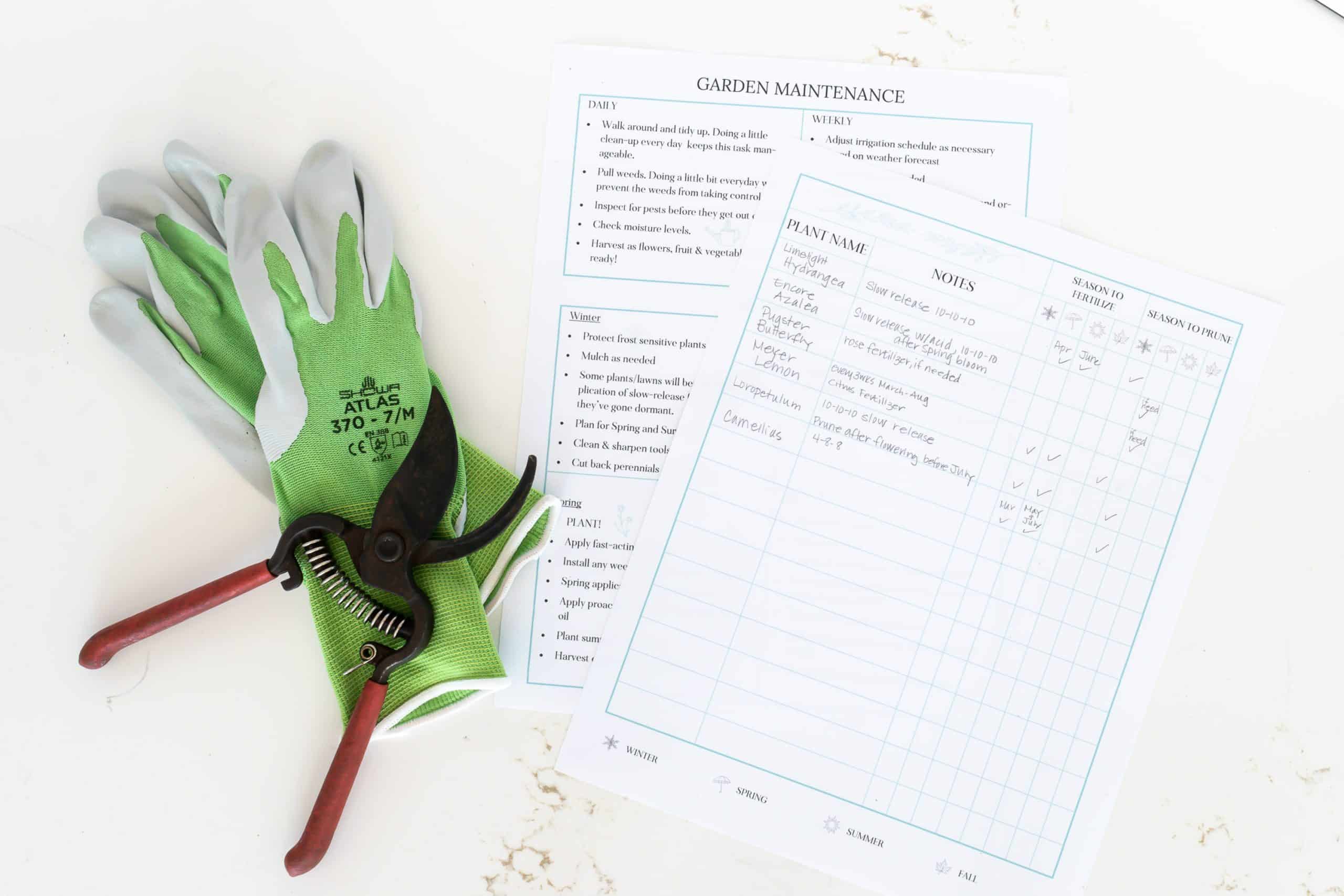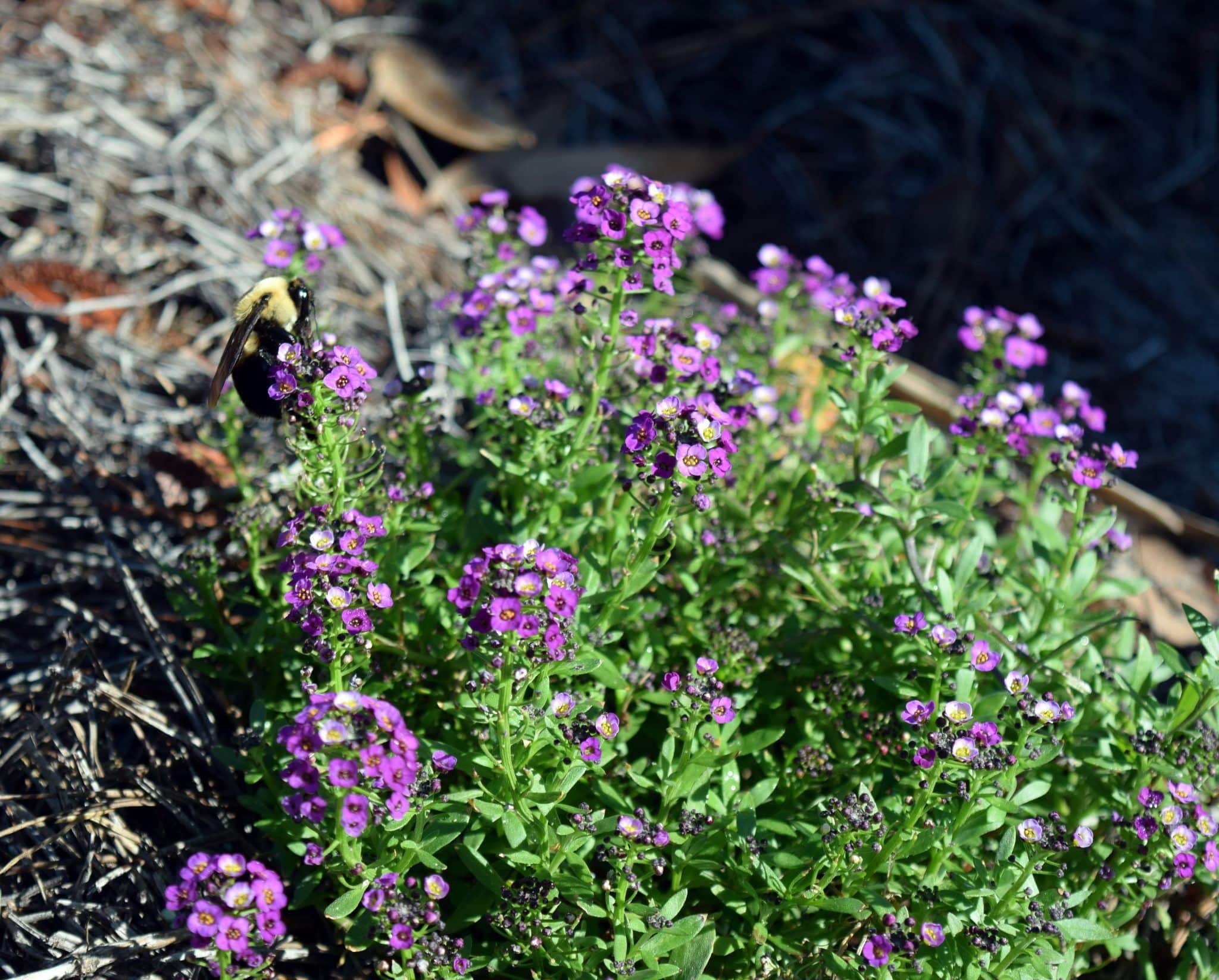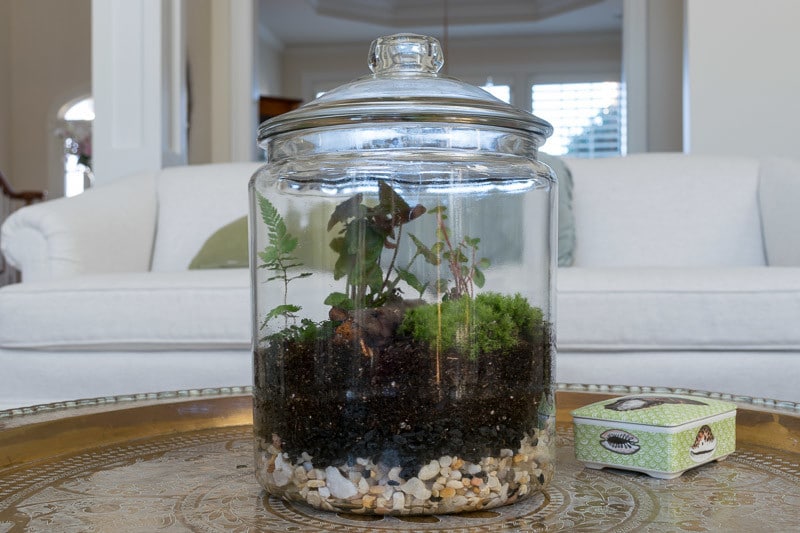Low-Maintenance Garden Tips
This post shares expert tips for a low-maintenance garden. It was written in collaboration with and compensated by PriceYourJob.co.
Gardens are wonderful things, providing outside space and a connection to nature. But they can take a lot of hard work to look after.
As we continue to work on our garden, we are sensitive to making sure that we aren’t creating more work for ourselves down the road. Additionally, we consciously try to make high-maintenance areas less maintenance. As we didn’t start our landscaping from scratch, it is an ongoing effort.
You might wonder whether there’s a way to reduce the effort without sacrificing color and interest. Thankfully, you can have a low-maintenance garden that’s feature-filled and stocked full of plants. These expert tips will help you achieve it.
Table of Contents
Make Your Boundaries Low Maintenance
Fence Boundaries
Whether you prefer a fence or hedge, there are plenty of ways to make your boundaries easy to care for.
When installing fences, there are a few steps you can take to ensure minimal maintenance.
Going for pressure-treated wood panels instead of dip-treated ones will make your fencing cost a little higher, but it will stand up better to extreme weather and rot. So, it should last longer without needing to spend extra time maintaining it. You can boost this durability by adding gravel boards to the base of your panels and caps on the tops of the posts to stop the wood from soaking up moisture and rotting.
What Is a Gravel Board?
A gravel board is a horizontal panel typically made of concrete or treated timber placed at the base of a fence. Its purpose is to protect the bottom of the fence panels from ground moisture, which can lead to rot and decay over time.
The gravel board at the bottom of the fence acts as a barrier, preventing direct contact between the fence panels and the ground. This helps extend the fence’s lifespan by reducing the risk of water damage and decay. Additionally, gravel boards can help deter pests like rodents from burrowing under the fence and causing damage.

Another alternative is to use composite panels resistant to UV rays and fading. These need little more than a quick washdown every six months and should last for decades.
Hedge Boundaries
Traditional box hedging can suffer from blight, rust, and caterpillars, so if you’re looking to add a natural boundary to your garden, it’s worth considering other planting options that are more resistant to pests and disease.
To reduce your hedge’s needs further, consider choose a drought-tolerant and slow-growing plant species. Euonymus Japonicus ‘Jean Hugues’ looks similar to box hedging but isn’t susceptible to the same problems. And as it doesn’t grow more than 8 inches (20cm) per year, you can spend less time trimming it. Yew is also slow-growing, making it another good plant for low-maintenance hedging. Photinia ‘Red Robin’ also requires minimal pruning, making it an equally popular choice for easy-care gardens.
- Photinia ‘Red Robin’
- Euonymus Japonicus ‘Jean Hugues’
- Yew
Choose a Low-Maintenance Garden Patio
Although patios are generally low maintenance, there are one or two tricks you can use to ensure they look good with minimal effort.
Many porous slabs, such as concrete and limestone, can benefit from sealing. This stops them from staining and increases their durability, so you spend less time cleaning and maintaining them.
One of the easiest patio surfaces to maintain is porcelain. Just be sure you choose tiles intended for outdoor use. Porcelain doesn’t soak up water, so it doesn’t tend to stain, and the smooth surface of these tiles makes them easy to wipe over.
But to reduce maintenance on any patio, install it with a slight slope so that rainwater runs off. Also, try to position it where sunlight can reach it. This will prevent algae growth, saving the need for frequent scrubbing or pressure washing.
Grow A Low-Maintenance Garden in Raised Beds and Containers
A low-maintenance garden can still have plenty of plants growing in it. But to keep jobs like sowing, weeding, feeding and pruning to a minimum, there are some tweaks you can make.
Growing in raised beds and containers has several advantages over traditional borders regarding low-maintenance gardens. Firstly, they’re higher up, so there’s less bending to do, reducing the physical strain of gardening. Growing in this way also reduces the spread of weeds and helps to keep plants contained. So, even clump-forming and ground-cover plants stay neat and tidy without too much effort.
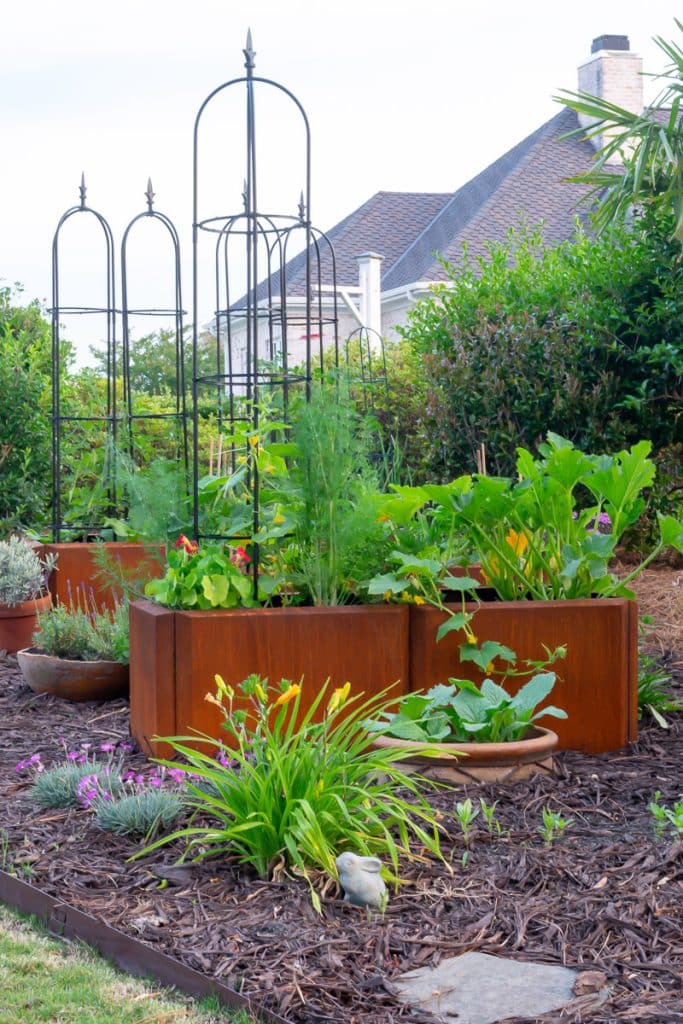
Choose Plants Wisely
To make your job even easier, you might want to consider changing the types of plants you grow. Choosing perennial flowers over annuals means they’ll return yearly, so you don’t have to keep shopping for and potting up new plants every spring and summer.
If you’re planting flower bulbs, go for varieties that are happy to be left in the ground – this saves the need to dig them up and store them over winter.

Shrubs and ornamental grasses are generally easy to care for, so consider planting more of them to reduce tasks such as deadheading.
Finally, top your beds and pots with mulch. This will help add nutrients and encourage soil-invigorating insects while reducing weed growth and aiding moisture retention, so there’s less watering to do.
Consider Altering or Replacing Your Lawn
Mowing, weeding, and feeding a lawn can take up much of your time. For a true low-maintenance garden, you might consider making a few changes or replacing it altogether.
Edging your lawn with stone pavers can help keep it neat without breaking out the edging tools. Choosing a slow-growing fescue grass mix can improve your lawn’s resilience and reduce the need for mowing every weekend. Alternatively, you could choose a wild meadow lawn, reducing both mowing and feeding requirements while boosting color and interest.
If you’re not a fan of weeding and watering, another option might be making a gravel garden. This type of garden is growing in popularity as it’s low-maintenance and suitable for areas that suffer from droughts. The horticultural fabric underneath the gravel keeps the weeds at bay, and by choosing hardy and unfussy plants, you can spend more time enjoying the garden and less time maintaining it.

In conclusion, achieving a low-maintenance garden doesn’t mean sacrificing beauty or variety. By implementing expert tips such as choosing durable fencing materials like pressure-treated wood or composite panels, opting for low-maintenance boundary plants like slow-growing hedges, selecting easy-to-maintain patio surfaces like porcelain, and utilizing raised beds and containers for planting, you can significantly reduce the time and effort required for garden upkeep. Additionally, thoughtful plant selection, mulching, and considering alternatives to traditional lawns can further streamline maintenance tasks, allowing you to spend more time enjoying your outdoor space with less hassle. With these tips, creating a vibrant and flourishing garden that requires minimal maintenance becomes achievable for any gardening enthusiast.
Bookmark this page or pin the following image to return to this article with tips on low-maintenance gardens in the future.
Thanks so much for spending a few minutes of your busy day with me!
To ensure you don’t miss future content, pop your email in the pale green box on the right or click here. I usually send one email weekly, so I won’t inundate your inbox. I’m sensitive to an overflowing email inbox!
We will only use your email address to send you emails, no more than 1-2 weekly. In addition, you will have access to my growing library of knit & crochet patterns and other printables. Check back often as this library will continue to grow. You can unsubscribe anytime by emailing me or clicking on the “unsubscribe” link at the bottom of all emails.
And you can access many of the products I refer to on my Nourish and Nestle Amazon Page. You can access it here.
So, if you’d like to participate in the ‘subscriber benefit’ action, simply subscribe to Nourish and Nestle here or use the form on the right sidebar. It’s slightly towards the top.
I have sent all my subscribers the link to the Subscriber Benefits Library. If you missed it or misplaced it, let me know.
Until next time…


